Maximilian and Charlotte: the sad story of emperors in love in the art of Miramare Castle
One of the paintings that stuck with us most, during and after our visit to the Miramare Castle in Trieste, is the one depicting the departure of Maximilian of Habsburg-Lorraine and Charlotte of Belgium for Mexico. The painter Cesare Dell’Acqua immortalized that veryApril 14, 1864: a jubilant crowd, in a blaze of Austrian flags, greeting the Archduke of Austria and his wife, already embarked on the liner that would take them to the frigate Novara, which we see at sea in the background. Maximilian and Charlotte are facing the audience, composed, in an attitude, we might say, solemn and official. On the lance, the Mexican flag has been hoisted: Maximilian is in fact leaving for America where he will exercise his role asEmperor of Mexico. On the left, there is a glimpse of Miramare Castle.
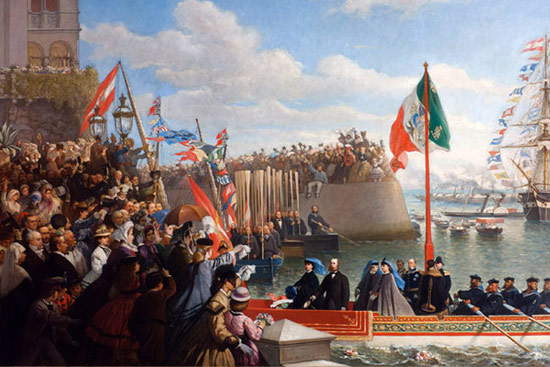 |
| Cesare Dell’Acqua, Departure of Maximilian and Charlotte for Mexico; 1866; Trieste, Miramare Castle. |
The vicissitudes of the castle are inextricably linked to those of the archduke: on our websitewe had already talked about Miramare Castle, describing its history and the museum itinerary (as Ilaria is wont to do in her "Museums of Italy" space), but we had preferred to postpone an in-depth study devoted to the fictional figure of Archduke Maximilian, who had the castle built but managed to enjoy it for only four years. From Mexico, in fact, he would never return.
That he was not a particularly fortunate character was perhaps understood from his first political appointment of any significance: in 1857, in fact, Maximilian was appointed viceroy of Lombardy-Venetia, in the midst of the Risorgimento. However, the appointment was revoked from him by his brother, the Austrian Emperor Franz Joseph, who was well known in Italian historical events, just days before the start of the war against the Piedmontese. Indeed, Maximilian was always inclined to curry favor with the people of Lombardy-Veneto with reforms that would grant greater autonomy to the Austrian lands on Italian soil. However, his intentions were not well regarded by the central government of the Empire: the archduke was evidently too modern a ruler and too much on the side of the people, so much so that Cavour himself began to seriously worry that if Maximilian gained the favor of the people of Lombardy-Venetia (and, of course, high society as well), his intentions to unite Italy would founder (although relations with Piedmont continued to remain tense). Franz Joseph, given Maximilian’s excessive liberality, revoked his appointment, and the archduke, probably disappointed, decided, at only twenty-seven years of age, to retire from the political scene and settled in Miramare where he began to lead a life far removed from his brother’s wars and designs of empire.
These were carefree years: Maximilian and Charlotte, who had married for true love and not for family designs, as is often the case in those circles (it seems that the princess had fallen in love with the archduke from their first meeting), lived out their romantic affair and spent a quiet existence devoted to walks by the sea or in the castle park, music, culture, and painting. Charlotte herself was an interesting artist: she delighted in making views, many of which can be found today in the very halls of Miramare Castle.
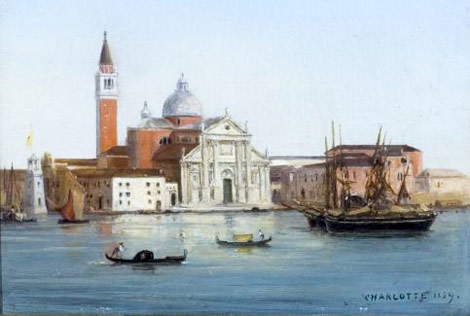 |
| Charlotte of Belgium, View of San Giorgio Maggiore in Venice; 1859; Trieste, Castle of Miramare |
Maximilian again had the opportunity to return to the scene "as a protagonist" in 1864; this time, however, the archduke would pay dearly for his desire for redemption. On April 10 of that year, a group ofMexican delegates arrived at Miramare Castle to bring him the crown of Emperor of Mexico, which had been offered to him a few months earlier, on October 3, 1863. As we have seen, four days later, Maximilian, already crowned, left to take possession of his empire: he arrived in Veracruz on May 28, 1864, after more than a month of travel.
However, Maximilian did not know the real and extremely complicated political situation in Mexico: torn apart by years of civil war, with a territory that had shrunk by about half, compared to that of the declaration of independence, after a disastrous war against the United States that had taken advantage of Mexican instability, and with continuous clashes between the various political factions that led to several coups d’état, Mexico was shattered, in 1860, by yet another intestine war. There emerged the figure of Benito Juárez, a liberal, now considered one of Mexico’s leading national figures, who became president of the republic in 1861. One of his most controversial measures was to block for two years the payment of debts to foreign powers-Spain, France, and England-who, in order to offset their claims, decided to occupy certain areas of Mexico.
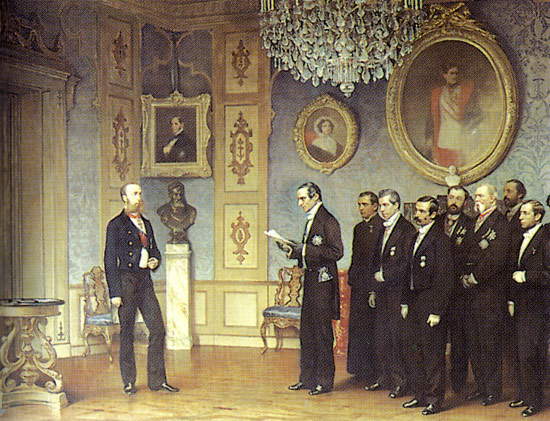 |
| Cesare Dell’Acqua, Maximilian receives Mexican delegates; 1867; Trieste, Castello di Miramare |
Spain and England, thanks to Juárez’s negotiations, withdrew from the enterprise, but France, led by Napoleon III, continued the occupation until it reached Mexico City. Juárez was then forced out of the presidency of the republic, and at the instigation of France, an assembly of Mexican conservatives took office and proclaimed theEmpire. Someone was needed to be emperor, and the choice fell squarely on the young and inexperiencedMaximilian: probably, a thoughtful and experienced ruler would have thought twice before agreeing to rule an unstable country, in deep economic crisis, and prey to constant internal struggles with an always uncertain outcome. Nevertheless, the archduke accepted the crown, perhaps also to make up for the subordinate position to which he had been forced by his brother; but in these machinations, it is not difficult to see that Maximilian would have been the victim.
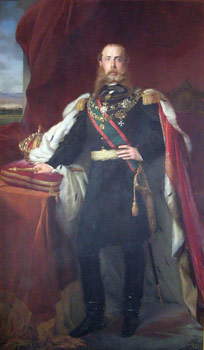 |
| Santiago Rebull, Portrait of Maximilian as Emperor of Mexico; 1865; Trieste, Castello di Miramare |
Liberals, with republican tendencies, could not in fact accept a monarchy, moreover ruled by a foreign ruler. Not to mention the fact that the presence of a European power in America would counteract theinterests of the United States. In spite of this, Maximilian went to Mexico, without even being able to count on the support of his brother Franz Joseph: in fact, the latter considered the venture counterproductive, both economically and diplomatically, because the Mexican empire, as mentioned above, would surely have friction with the United States.
Maximilian was a person of good feelings and had excellent intentions: but good feelings and excellent intentions, combined with the bit of ambition, vanity, and frustration that came with being the younger brother of one of Europe’s most powerful emperors, soon found themselves at odds with the reality of the facts. A reality of facts of which Maximilian was completely unaware: he had no cognizance of how boiling hot the situation in Mexico was. The reforms he tried to implement (which were few, due to lack of time) did not allow him to attract the goodwill of the liberals, who saw him anyway as an invader who had arrived from Europe (not least because Maximilian had ordered the republican rebels to submit to the crown on pain of being shot), and they also alienated him from much of the conservative factions. And the United States also supported Juárez, who was organizing to regain power. Napoleon III, seeing the situation, and with the United States threatening intervention against the French, prudently preferred to withdraw his troops from Mexico: this was March 1867. Maximilian found himself completely alone facing an entire country that had risen up against him. The Republicans took very little time to capture him: and the sentence was one of death sentence, although pleas for pardon came from Europe. The unfortunate young emperor’s life ended on June 19, 1867 in the small town of Querétaro: Maximilian was shot.
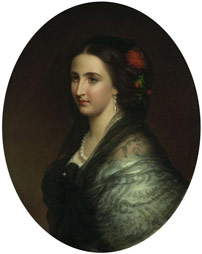 |
| Tiburcio Sánchez, Portrait of Charlotte; 1866; Trieste, Miramare Castle. |
Thus ended the dream of a ruler who was always guided by the will to govern as best he could and to do good, but who could do nothing against inexperience, naiveté, mistakes and designs that involved him perhaps in spite of himself. The dream was to create a just state, respectful of its people, and with an enlightened government that would advance the entire nation in every field, but he had neither the time nor the opportunities to realize it. With the end of Maximilian, so too ended the love dream of the beautiful Charlotte. Shortly before the withdrawal of French troops, she had returned to Europe: for her, the situation in Mexico had become too dangerous. She seemed to foresee her husband’s fate as early as her return to Miramare: she began to show signs of imbalance, so much so that for some time she was even kept under close observation (some historians say she was locked up) in the Castelletto of Miramare Park in Trieste. After the tragic death of her husband, by then ravaged by madness, she was taken back to Belgium at the behest of her sister-in-law Maria Enrichetta of Habsburg-Lorraine to then spend the rest of her life in Bouchout Castle near Brussels.
Today, it is Miramare Castlethat bears the strongest witness to the story of Maximilian and Charlotte: every room, every wall, every piece of furniture tells the dreams of the two young lovers, as well as their sad fate. We can see their portraits everywhere: they are celebratory, official portraits, but although their expressions are serious, their eyes communicate to us the sincerity of their soul. And this soul will always remain locked within the walls of Trieste’s Miramare Castle, which will continue to tell visitors this story of culture, art, politics, revolutions and love.
Warning: the translation into English of the original Italian article was created using automatic tools. We undertake to review all articles, but we do not guarantee the total absence of inaccuracies in the translation due to the program. You can find the original by clicking on the ITA button. If you find any mistake,please contact us.




























